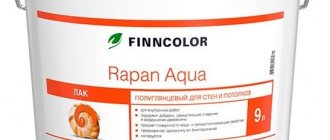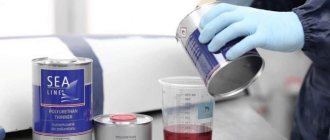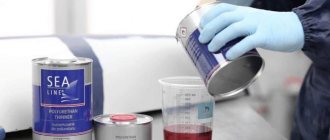Advantages and disadvantages of acrylic paint for fabric
To choose an acrylic color for application to fabric, you need to find out what features, advantages and disadvantages it has. This will help you understand whether it is possible, for example, to use acrylic painting on raincoats, jackets, bags, umbrellas and other things that are used outdoors in wet weather. Or, for example, find out how acrylic paint will behave on slippery silk or synthetic fabric.
Linen bag trimmed with braid, lace and painted with acrylic paints Source pinterest.ru
Application area
Fabric dyeing is used in various industries:
- Furniture industry. The unique upholstery of a sofa or chairs is often a source of pride for the owners.
- In the fashion industry. Every year, fashion designers show us the fashionable colors of the new season from the catwalks.
- Creation of interior items. Various panels, tablecloths, paintings, curtains add their own flavor to the design of the room.
At home, faded or worn items are often given new life with the help of paints. Needlewomen use various pigments to paint decorative napkins and clothing accessories.
pros
Characteristics and advantages of acrylic paints for painting on textile or knitted fabric:
- Wide selection of colors and shades.
- Colors can be mixed, diluted with white, shaded with dark to obtain original tones.
- High ductility during distribution.
- Fast drying.
- Moisture resistance of the coating and resistance to temperature changes and frost.
- Preserving the integrity of the patterned coating during machine washing, creasing, folding, and folded storage.
- Environmentally friendly material.
- They have antiseptic properties due to the content of acrylic resins.
- No pungent specific odor.
Painted jackets are not afraid of either rain or snow if the designs are made with acrylic. It is not at all afraid of moisture, water or sub-zero temperatures. An additional advantage of such paints is their affordable price. This is an excellent choice for beginners in the field of coloring and painting fabrics.
Ethnic Petrykivka painting with acrylic paints on light scarf fabric Source pinterest.ru
The denim jacket is beautifully finished with fun hand-painted acrylic paints Source livemaster.ru
Stylish sneakers with a denim top, decorated with acrylic paints Source m.alibaba.com
Where to start
Acrylic painting on a wall is impossible without proper surface preparation. How tedious and time-consuming this process will be depends on the initial condition of the wall and the type of its initial finish. If the room is covered with wallpaper, you will have to remove it.
Oil or alkyd paint also needs to be removed, because the acrylic coloring composition will not adhere to such a coating. The plastered surface does not need cleaning if the material lies flat and does not crumble. How to prepare a wall:
- Everything unnecessary - away! Use a spatula, a hair dryer or a drill with a stiff wire brush attachment (the latter option is suitable for removing old oil paint).
- Wash the wall or vacuum it. There should be no dust on the surface.
- The dry and clean base must be leveled. Do this using a quality putty, wait until it is completely dry, and sand the repaired areas with medium-grit sandpaper.
- Cover the wall with a layer of acrylic-based primer. This will ensure reliable adhesion of the coloring material to the surface. Dry.
- Apply base color acrylic paint. It needs to be determined based on what background you plan to draw on. If you intend to paint the entire wall, then choose a neutral, light background. It will be convenient to make a preliminary sketch of a painting or ornament.
- Now it's time to coat the wall with a special artistic acrylic primer.
All! The surface is prepared.
Cons and limitations
Acrylic paints cannot be called a one hundred percent widely used finishing material. Despite the fact that they are popular in various fields of activity and handicrafts, there are limitations to their use.
Types of things you should not paint on with acrylics:
- Bed sheets. Repeated washing will quickly fade and erase the design.
- Personal underwear. There is a possibility of an allergic reaction.
- Children's things (for children of kindergarten age). There is the same danger of allergies.
- Any textile, knitted or woven products that are dry cleaned. The drawing will simply be ruined.
Over time, the acrylic coating deteriorates (wears off, cracks). Without contours, paint often bleeds. Sometimes it is difficult to achieve the desired shade when mixing paints.
Factory-made bed linen with patterns made from acrylic paints is made using special technology Source selcdn.fedsp.com
Factory-made children's clothes are decorated with acrylic paints using special technology Source livemaster.ru
Canvas grain
The grain of the canvas can be different, this helps to obtain different designs. The types are suitable for creating various techniques, and are chosen by the artist based on the general idea.
The grain of the canvas can be different, this helps to obtain different designs.
Fine grain canvas
The fabric has a smooth texture. More suitable for painting in thin layers. It is very convenient to write down the smallest elements on such a basis, emphasizing the details.
More suitable for painting in thin layers.
Coarse canvas
Usually chosen to create large sized works. Under mechanical loads, the structure does not change. A suitable option for impasto painting.
Usually chosen to create large sized works.
Scenic canvas
Suitable for oil paints; not used with acrylic and tempera paints due to their ability to allow moisture to pass through. Made from 100% linen fabric. Resistant to stretching and sagging, even when thick layers of dyes are applied.
Made from 100% linen fabric.
Criteria for choosing suitable paint and fabric
For light fabrics, you can select paints of bright colors and rich variations of their undertones. Translucent and transparent options are suitable here. Dark textiles are painted with paints containing a high density of color pigments. They are also used as decoration based on the material.
Using translucent acrylic paints for painting on light fabric Source static.tildacdn.com
The use of highly opaque and translucent acrylic paints for drawing Source madeheart.com
The classification of acrylic paints for painting on woven fabric is grouped according to the following criteria:
- Fabric type – for silk, cotton, viscose, wool, linen, synthetic and mixed textile materials, universal, for dark and light fabrics.
- Purpose - for drawing figures and painting, for creating contours, contour reserves, coloring (if you need to change the color of the fabric entirely or in some place).
- Temperature of shades – cold, warm colors.
- Transparency, hiding power - transparent, translucent, opaque.
- Degrees of gloss – glossy, matte and their softening (for example, semi-gloss).
- Blend - in tubes, jars or aerosol.
The density of the resulting coating layer plays a big role. This determines whether you will have to apply 2 or 3 layers, or whether one will be enough. Medium coverage paints provide a coating through which the fabric will be slightly visible. High coverage options will give you rich color in just one stroke. Such paints apply tightly, despite their normal consistency and spreadability.
Ideas: what things can be painted
Traditionally, silk scarves, stoles, shawls and dresses were decorated using the batik technique. Since the art originated in Indonesia, its native motifs are flowers, plants, birds and landscapes.
For a “test of the pen”, you can take a plain cotton T-shirt and design it using the shibori technique - you will get a bright summer design in the form of a spiral with diverging rays. A frame from your favorite cartoon would look good on a children's sweatshirt - such drawings have a clear outline and large shapes, they will be easy to work with.
After practicing on small items, you can paint a decorative pillowcase or bedspread for the bedroom, wall panel, tablecloth or curtain. The color and motifs of the work will depend on the style of your interior.
If you look for outline drawings for batik on the Internet, you can safely add to them templates for stained glass painting - these techniques have a similar principle.
We wish you successful experiments!
Types of coloring and nuances of techniques
There are the following methods of applying paint:
- manually with a brush;
- with stencil;
- with a textured roller, rolling pin;
- heel - special prints with three-dimensional images;
- using a foam swab;
- combinations of brush work with relief contours.
Using the batik painting technique, you must secure the edges, individual sections or all fields of the design so that the colors do not mix. For these purposes, a reserve circuit is used. This is a type of composition that is capable of fixing paint so that it does not merge with adjacent paint of a different color. You can call such a product in other words – paint protection. Another name for it is a fixative for an already applied coating.
Painting with a brush and acrylic paints on fabric Source gidpokraske.ru
Plywood stencils for creating designs on denim with acrylic paint Source shebby-shik.ru
A wooden textured rolling pin does an excellent job of applying acrylic paint Source tais-wear.ru
Dyeing fabrics with natural dyes: step-by-step instructions
How to dye fabric if you only have the contents of the refrigerator and groceries?
The following step-by-step instructions will help you avoid mistakes:
- Grind the coloring ingredient with a knife or grater, if necessary.
- Place in a saucepan and add water in a ratio of 1 to 2.
- Bring to a boil and leave for an hour. For a more saturated pigment, you can leave the liquid overnight.
- Strain the water thoroughly: make sure that there are no small pieces left in it - otherwise they will leave stains on your clothes.
- Prepare a paint fixative: if you are using berry or fruit juice, add half a cup of salt to 2 liters of water, bring to a boil, put a cloth there and boil for an hour. The proportions can be increased according to the size of the item being painted. If you paint with vegetables, spices or herbs, you need a vinegar solution. To prepare it, add four equal portions of water to one part of vinegar, put a cloth there and heat over low heat for an hour.
- After the time has passed, remove the item from the fixative solution and rinse in ice water.
- Dip the fabric into the dye and leave it for a while - the longer it stays there, the richer its final color will be.
When the product dries, the fabric will turn pale. Take this into account and paint the product longer if necessary.
Dyeing process
To draw on fabric you will need the following tools and equipment:
- dye;
- backup compositions, circuits;
- diluent;
- pencil;
- brushes;
- rollers;
- palette;
- templates;
- stencils;
- hoop;
- sponges, cotton swabs.
Before starting work, the fabric must be washed, dried, and then ironed. Then, prepare a workplace - a flat surface, free space for hand movements, lighting. A sketch or drawing should already be ready for the painting procedure.
Stages of painting fabric with acrylic paint using the batik method:
- The fabric area needs to be leveled and fixed. Many people use embroidery hoops for this.
- The design is transferred onto the fabric using tracing paper, dot technique or regular carbon paper.
- Those places that should remain unpainted are treated with molten wax.
- After the wax has dried, paint is applied manually in areas, or filled with dye (if continuous painting is used).
- Allow the paint to dry for the time specified in the instructions.
- Remove the wax - apply paper, heat with an iron (the paper will absorb everything), carefully separate the paper from the surface of the fabric. If necessary, apply paint of a different color to the areas where it was.
- Once completely dry, you can repeat the process to continue creating your design. This way you can get different combinations of shades (up to the very black).
Instead of a hoop, you can use any other device with which you can achieve normal alignment and tension of the fabric. This can be any frame or hard surface to which the edges of the textile product can only be attached with clothespins or stationery binders.
How to transfer a drawing
There are many ways to transfer images from paper to fabric. The most convenient option is if the fabric is thin, and the outline of the design on the paper is made with bold lines of saturated color, then you can simply place the design under the fabric and trace it. But if you draw on thick fabric or are unsure of the steadiness of your hand, try the following methods.
Method 1
Stretch the fabric, place carbon paper on it, and place the design on top. Carefully trace the contours of the design - the imprint will remain on the fabric. Used for light and dark fabrics - choose a carbon copy of the color that will stand out more strongly on your material.
Method 2
Make slits along the contour of the design with a stationery knife, leaving small bridges so that the design does not fall apart. Place the resulting stencil on the fabric and draw along the slits with a soft pencil or chalk in a color contrasting with the material. Carefully remove the drawing and complete the outline by sketching the gaps.
If the drawing is simple and monochromatic, and you are confident in your accuracy, you can immediately use a brush with paint instead of chalk.
Method 3
Take a thick needle, place the design on a soft surface and make many point punctures along the contour. Then transfer the paper to the secured cloth and sprinkle it with crushed chalk or pencil lead. Spread the powder over the surface using a cotton pad, pressing down slightly. Remove the paper and a dotted outline of the design will appear on the fabric.
Method 4
The original drawing must be on tracing paper. Trace it on the reverse side with a wet pencil or chalk, then carefully apply it to the fabric and iron it several times with your hand.
Method 5
With the help of light. Secure the fabric to a hard sheet of glass, plexiglass, plastic, or other material that allows light to pass through. Place the sheet on two stands (for example, two stools), between which a lamp is installed on the floor, pointing upward. Turn on the light and trace the drawing with a pencil or directly with an outline.
If you have a little experience and simple drawings, transferring the image may not be necessary - many people draw directly on the fabric.
Preparing the palette
The palette is used to mix colors and obtain new shades before applying paint to the canvas. Even a ceramic plate with a glossy surface can serve as a palette. But it is better to use a special artistic palette made of white plastic. It must be clean and have a smooth surface. On this basis, the shades of the spectrum are clearly visible and can be easily mixed with a brush.
To ensure that the paint sticks less to the palette and is easier to wash off later, the product should be sprayed with water from a spray bottle before work. The same can be done with paint applied to the palette. This technique will allow it to remain wet longer and maintain plasticity. After work (and sometimes during it, if the palette is too dirty), the tool must be washed. If the paint has not hardened too much, this can be done with water. And dried ones will have to be removed using a solvent.











